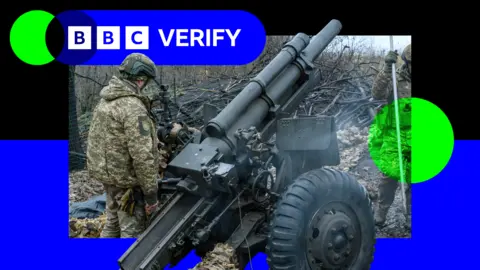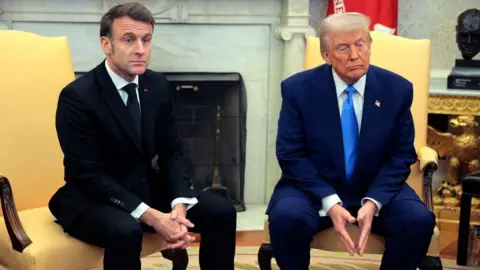How much has the US given to Ukraine?
 Getty Images
Getty ImagesThe visit of Ukraine President Volodymyr Zelensky to the White House for talks aimed at ending the war has put the scale of United States (US) support for Ukraine under the spotlight again.
President Donald Trump has criticised the amount of aid provided by the US compared to Europe in the past. But the figures he's previously cited are not backed by the evidence.
BBC Verify has been taking a close look at how much the US has spent since Russia's full-scale invasion of Ukraine in February 2022 and how it compares with Europe's contribution.
How much has the US spent in total?
The US has spent a total of $130.6bn (£98.9bn) between 24 January 2022 and 30 June 2025, according to the Kiel Institute, a Germany-based think tank that tracks international support for Ukraine.
The US Department of Defense has provided its own figure looking at all spending on Operation Atlantic Resolve - a response to Russia's invasion of Ukraine.
It says $184.8bn has been "appropriated" - a figure that covers US military training in Europe and replenishment of US defence stocks.
This total runs only to 31 March 2025, making it less up to date than the Kiel Institute's calculation - though notably higher.
BBC Verify has asked the US departments of Defense and State if they can supply more recent figures.
What has Trump previously claimed?
Back in February, when he was hosting France's President Macron, Trump claimed:
"We've spent more than $300bn and Europe has spent about $100bn - that's a big difference"
 Getty Images
Getty ImagesBBC Verify looked at the claim at the time and concluded Trump's numbers did not add up as the published numbers - from both Kiel and the US government - showed the US had spent a lot less than $300bn.
This remains the case six months on.
How does US spending compare to Europe?
It is true that the US is, by some margin, the largest single donor to Ukraine. But Europe combined has spent more money than the US, according to the Kiel Institute.
Between January 2022 and the end of June 2025, Europe as a whole spent $165.7bn on Ukraine, compared to the US's $130.6bn over the same period, according to Kiel Institute calculations.
The figure includes aid directly from the European Union (EU), but also from bilateral deals from European countries, both inside and outside the EU. It includes military, financial and humanitarian aid.
Will Europe get its money back while the United States doesn't?
Trump has previously claimed Europe would get its money back as it was "loaning" it to Ukraine.
This prompted Macron - who was sat next to the US president in their Oval Office meeting in February - to intervene, saying both Europe and the US had given a mixture of grants and loans.
President Macron is correct, according to Kiel figures specifically on financial aid. But the institute's figures also suggest President Trump has a point - the US has sent more grants, while the EU sent more loans.
However, again, there are different figures out there.
As of 18 July, the EU says its members have provided about $180bn so far, with loans making up 35% of the total.
Like the United States Department of Defense, the EU has used a broader definition of what counts as aid to Ukraine.
EU loans will have been on generous terms - so Ukraine will be repaying less interest than it would normally. In some cases, Ukraine isn't expected to pay anything, with repayments coming from revenues from frozen Russian assets.
What we can say is that aid to Ukraine has been a mixture of loans and grants.
How much has the UK given to Ukraine
The UK is one of the biggest individual state donors to Ukraine - the latest was a $2.8bn (£2.3bn) loan agreement signed during Zelensky's visit to London on 1 March.
At the end of July, the UK government had committed $29.5bn (£21.8bn) for Ukraine overall. This includes $17.6bn (£13bn) in military support.
The only countries to have spent more are the United States and Germany, according to Kiel data.
However, the UK's contributions are much smaller than the US
That raises a question for the UK and other European countries: if peace is not secured in the near future and US decides to withdraw a large part of its funding, can other states make up the difference?
That would require a significant increase in their current contributions.
Additional reporting: Thomas Spencer, Christine Jeavans and Daniel Wainwright



